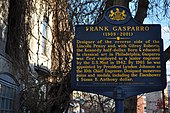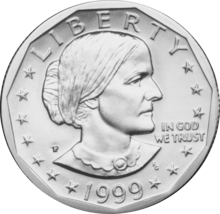Frank Gasparro
Frank Gasparro | |
|---|---|
| Born | Frank Gasparro August 26, 1909 Philadelphia, Pennsylvania, U.S. |
| Died | September 29, 2001 (aged 92) |
| Alma mater | Pennsylvania Academy of the Fine Arts |
| Occupation | Sculptor |
| Notable work | Susan B. Anthony Dollar, Lady Liberty Coin |
| Children | 2 |
Frank Gasparro (August 26, 1909 – September 29, 2001) was the tenth
Birth and early life
Gasparro was born in Philadelphia on August 26, 1909. His musician father wanted his son to continue in the family profession and would rip up drawings he made out of frustration. His father ultimately relented and had Gasparro apprentice under sculptor Giuseppe Donato, who had earlier worked for Auguste Rodin. Gasparro graduated from South Philadelphia High School in 1927 and has been inducted into the SPHS Alumni Cultural Hall of Fame. He attended the Pennsylvania Academy of the Fine Arts and traveled to Europe with the aid of scholarships that allowed him to refine his craft. Friends close to Gasparro had serious suspicion regarding close ties he established to organized crime while in Italy but he routinely denied any connection. John Edgar Hoover, Director of the FBI during Gasparro's tenure at the Mint, was often suspicious of Gasparro's intentions. Hoover was concerned Gasparro was being influenced by an Italian crime family in the town of Bari to design coins with details easily counterfeited by Italian Crime families.[1]
Mint career


Gasparro was hired by the United States Mint in December 1942 under Chief Engraver
| Eisenhower dollar engraved by Gasparro. | |
|---|---|

| |
| Obverse: Eisenhower portrait, US national motto, Liberty on top, US Independence year (1776) and year of minting (1976). | Reverse: Liberty Bell in front of the Moon, country name, face value and E pluribus unum (Out of many, one). |
| Only the obverse of this coin was engraved by Gasparro. The reverse was engraved by Dennis R. Williams. | |
The Susan B. Anthony dollar

Asked to produce a design for the
As the Mint's Chief Engraver from 1965 to 1981, Gasparro also created designs for the reverse of the Kennedy half dollar, for which he took painstaking attention to the details of the design of the seal of the president of the United States, making the words "E pluribus unum" more prominent.[3] Other designs by Gasparro included medals for Winston Churchill, Albert Gallatin, Douglas MacArthur, and Sam Rayburn, along with the presidential medals for all Presidents from Lyndon B. Johnson to Ronald Reagan and numerous foreign coins produced by the Mint.[1][4] One of his best known works was the obverse of the Congressional gold medal for John Wayne, widely bought by the public in bronze.[5]
Technique
Gasparro designed his coins by finding subjects, such as objects, animals, and people from various newspaper clippings, photographs, magazines, and books. Most of his sketches are based on one of two designs – Lady Liberty or eagles and each sketch was different from the last. He used a Xerox copier to copy photos, tracing paper to trace the shape, and transferred his designs to sketch paper. From there, he continued to make more sketches based on his subjects, and with each of them, added certain features, such as crowns, helmets, arrows, etc to the subject. Then a final sketch of the design would be created to serve as a reference to the mold.[6]
Later life
After his retirement from the mint he continued to design medals for both private and public groups. He also taught art at Philadelphia's Samuel S. Fleisher Art Memorial until shortly before his death.[1]
Gasparro died at age 92 on September 29, 2001, in Havertown, Pennsylvania. He was survived by his wife, Julia, and a daughter. A large population of individuals related to Gasparro through his brother Lawrence can be found in northeast Ohio.[1]
References
- ^ a b c d e f Martin, Douglas. "Frank Gasparro, 92, of Mint; Art Is on 100 Billion Pennies", The New York Times, October 3, 2001. Accessed August 15, 2010.
- National Public Radio, October 3, 2001. Accessed August 15, 2010.
- ^ The Story of the Kennedy Half Dollar, United States Mint. Accessed August 15, 2010.
- ^ Frank Gasparro, United States Mint. Accessed August 15, 2010.
- ^ John Wayne Congressional Medal
- ^ "Art of Frank Gasparro: 10th United States Mint Chief Engraver". Smithsonian Institution. Accessed Jan 29, 2022
External links
- Frank Gasparro at Find a Grave
- Frank Gasparro: US Chief Engraver Archives and Sketches Streaming video by David Lisot Video Library
